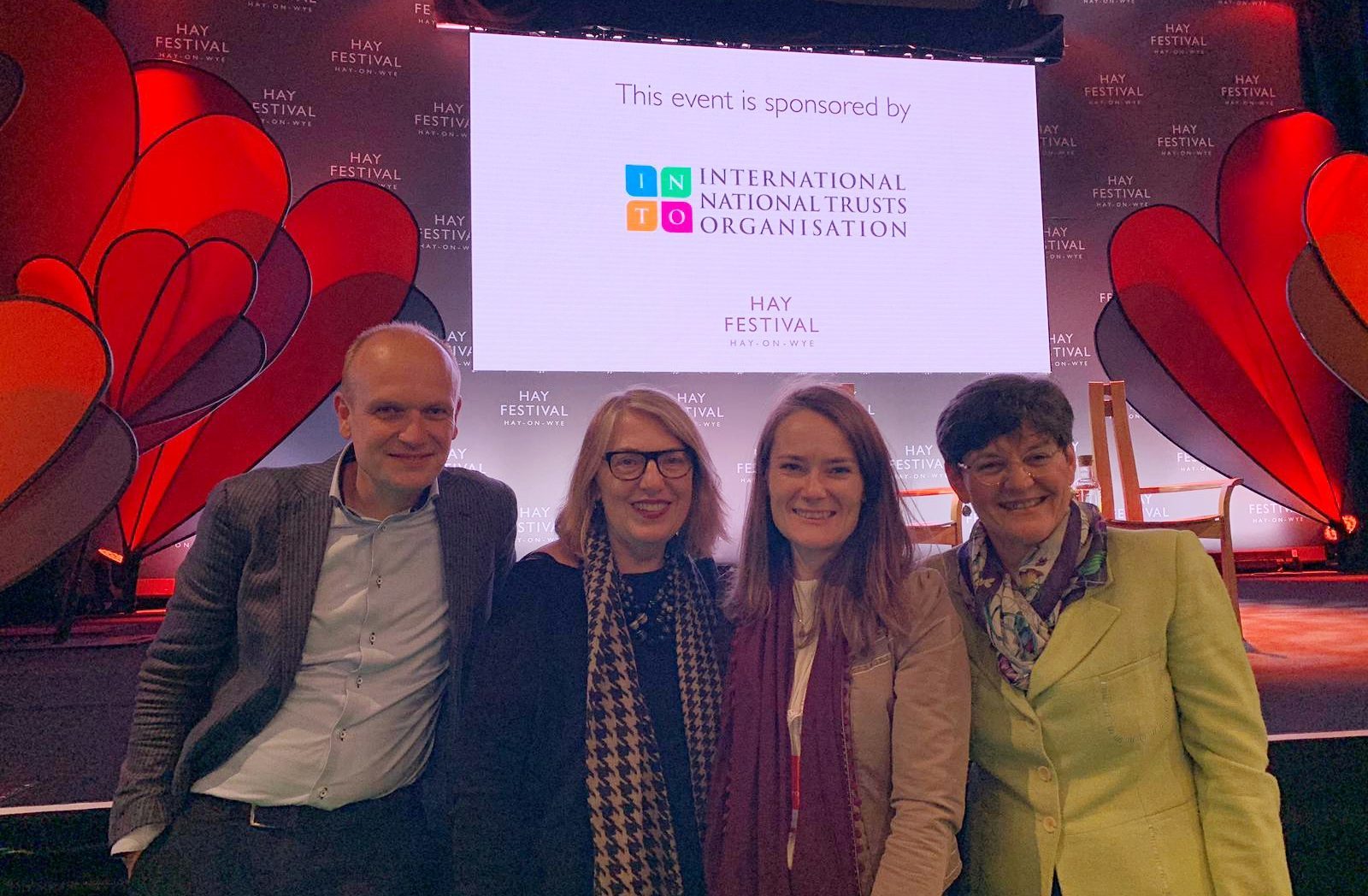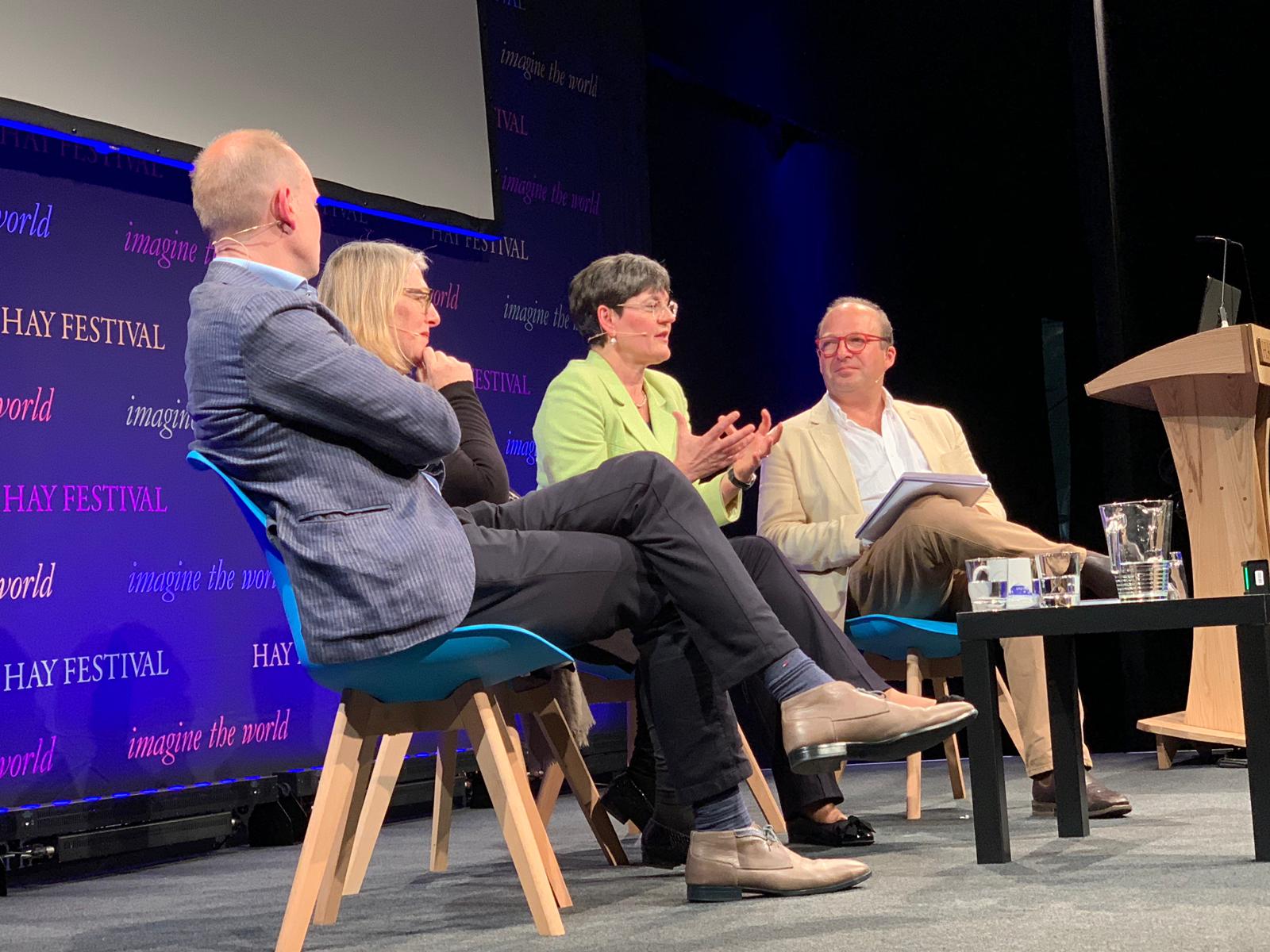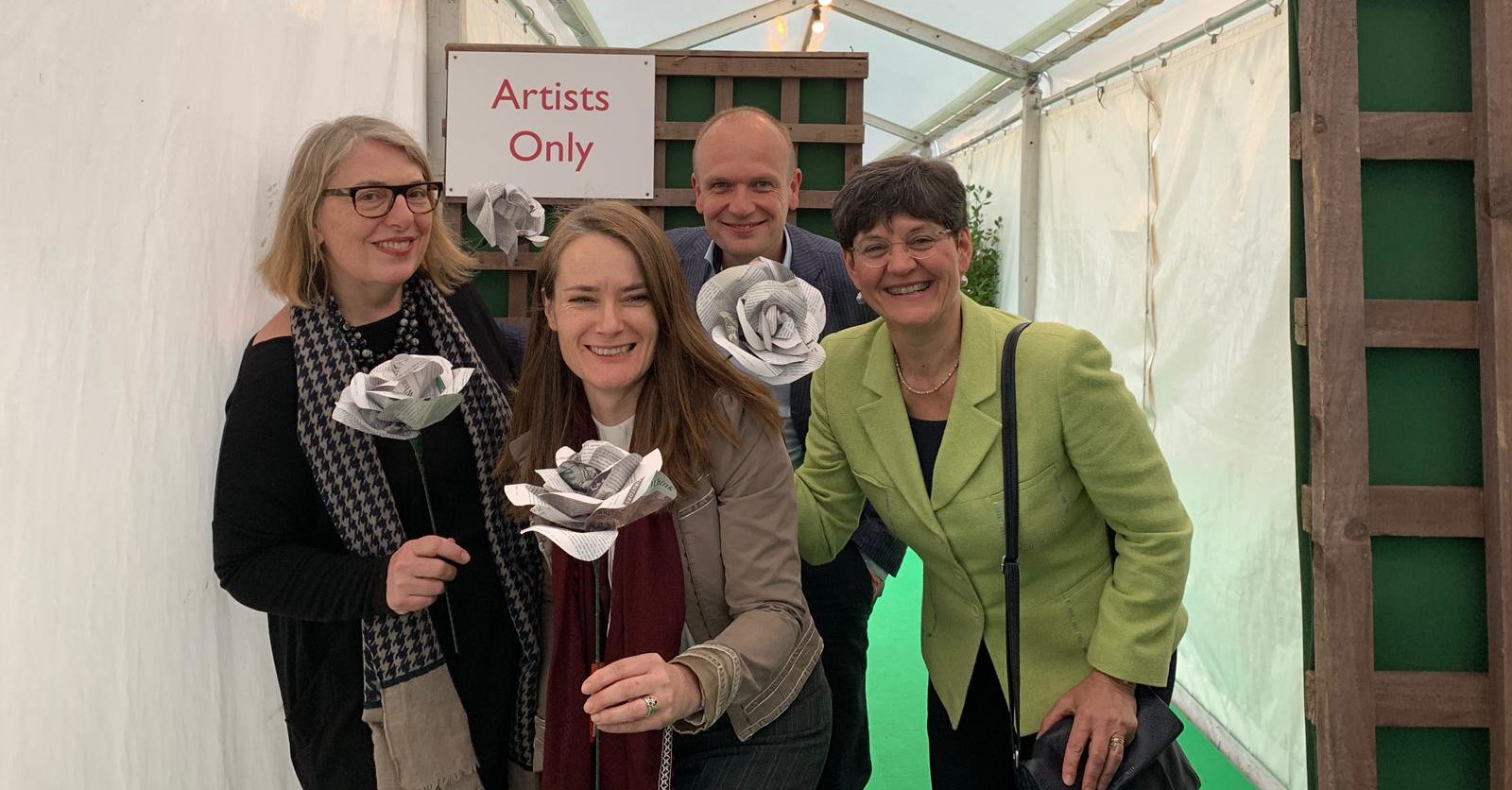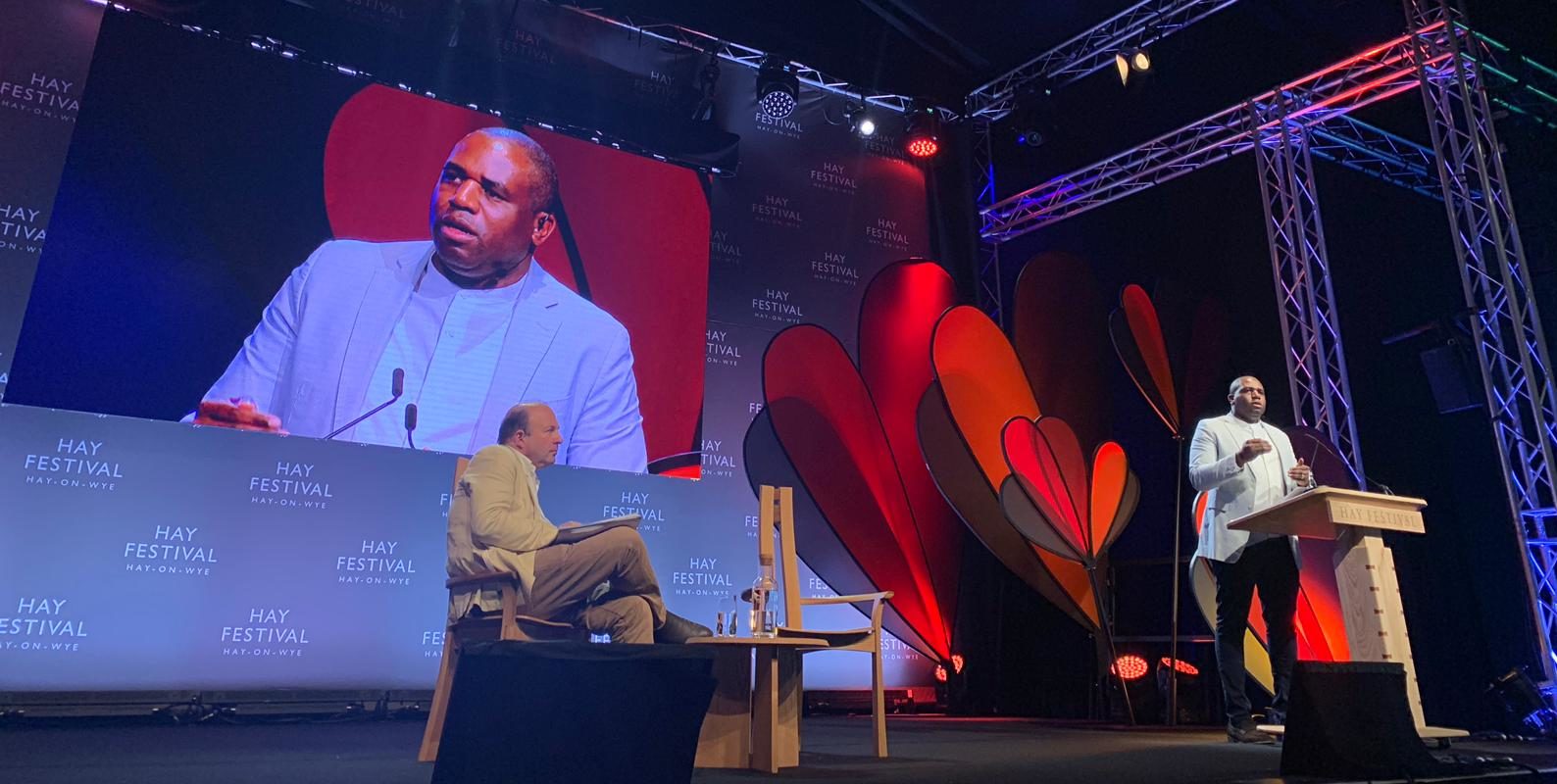-
The idea of European unity (Weekly blog, 2 June 2019)
Posted on June 2, 2019A blog by Catherine Leonard, Secretary-General
National Identity and the idea of European unity
Last week, we invited experts to discuss local loyalties in relation to the cosmopolitan ideal of world citizenship. Irena Edwards, Chairman of the Czech National Trust, Joep de Roo from the Innocastle project and Sneška Quaedvlieg-Mihailović, Secretary-General of Europa Nostra took to the stage at the Hay Festival. Justin Albert moderated the discussion which explored how we maintain and celebrate national distinctiveness in the face of globalisation; what role cultural heritage can play as we learn to understand each other and accept diversity; and whether it can help us bridge the gaps, both at home and abroad.

Balkan background
It was an opportunity to bring to life our important partnership with Europa Nostra; to show how we have supported the development of a new European Trust in the Czech Republic and to present our work with the Innocastle project. Innocastle seeks to demonstrate the importance of partnership in the sustainable revitalisation and future-proofing of heritage sites. It will also alert policy makers to the need for effective funding to enable them to become self-sufficient. Lastly, Innocastle has a big focus on our shared European identity, which is highly relevant to the discussion.
Sneška began by explaining that she came from a country that does not exist anymore – Yugoslavia. She is proud of her Serbian roots but also proud of the Netherlands, the country of her husband. And of Europe. Moreover she is fighting to promote the concept that we can all be European, whether Serb, Welsh or Dutch.
Sneška stressed that it is a shared culture not Brussels or politicians that bring Europe together. She said that when we watched Notre Dame burn we all felt we were losing something. We can all love the local and the European – that is not a contradiction. She also stressed the need to have different perspectives on history, not just a nationalistic one.
Another brick in the wall
Joep recalled how everyone wanted to be at the Pink Floyd concert in Berlin after the Wall came down. Heritage and culture has the power to bring people together across borders.
He explained that the Innocastle project is working with people all over Europe to tell our shared story. Moreover this event marked the culmination of a study visit by a large delegation that had come to learn from each other in Wales. The team had heard about ways to bring heritage back into the hands of people. Also how to engage the young and how to be financially sustainable. The importance of collaboration was highlighted.
Irena spoke about camping in Zagreb aged 13 when the Russians invaded her homeland, Czechoslovakia, in 1968. She came to England in the late 1980s and eventually had a successful career as a lawyer. But her ‘tribe was calling’ and she set up the Czech National Trust five years ago. Her grandmother had been the custodian of a castle so she understood the attraction – and challenges!
Joep explained that he had lived in Romania for 8 years. He had seen how civil society could develop community feeling by focussing on the small and intimate. He stressed the importance of telling the right stories and reaching out to the wider community. The National Trust with all its volunteers was a good example of this, he added.

Unity in diversity
There is nothing wrong with being part of a tribe. But only if you share common values and remain collaborative and open. Sneška added that Europe is not homogenous. And that it is diversity that makes it strong. She also recommended looking for European and global stories in the local community, local heritage.
The answer will never be to build walls and fences, but rather bridges. Justin explained that a recent survey of Tredegar House near Newport showed that every European country was represented in the collection and stories. Every continent, even.
Local property
Irena described the importance of ‘need’ and catching the public’s imagination with your first property. She told the story of the Czech National Trust’s first site, the tomb of writer, Marie von Ebner-Eschenbach. The Communist era had been very damaging to the physical heritage, but also people’s attitudes. There is an expectation that the state will do everything. So selling the concept of a heritage ngo is challenging. However, one of the ways to shine a light on the issue was through INTO working holidays. Overseas volunteers have proven a catalyst for uniting people to save property.
Joep described a Romanian castle that had been restituted to its former owner, Count Teleki, and his efforts to restore it. He reflected on the story of Hay Castle and its saving by the local community.

Heritage can bring us together
Sneška finished the presentation by talking about the European Year of Cultural Heritage in 2018. We can’t reduce Europe to economics – it has to have a soul. Moreover it is a vehicle for peace and reconciliation. She explained how important heritage features had been destroyed in Yugoslavia to damage the opposition. But that after the war, people had come together to rebuild the Bridge at Mostar, for example. It was a similar story in Nicosia where a divided city is being glued back together through the heritage of the Buffer Zone. She expressed hope that cultural heritage could bring communities back together in the UK too and called from more investment in culture and education.
Political apathy
INTO also sponsored David Lammy’s Octavia Hill Lecture on Tribes, chaired by our Trustee, Justin Albert.
When The Rt Hon David Lammy MP, Member of Parliament for Tottenham, first entered the House of Commons in 2000, he said the country was suffering from political ‘apathy’. (Interesting that we used the same word to describe the biggest threat to heritage in our 2016 ‘State of Global Heritage Report’.) He said the slow hand clap given to Tony Blair by the Women’s Institute Conference was about as shocking as politics got in those days. By contrast he asked how can you not be passionate today with everything that’s happening.
Lammy spoke about the different tribes he belongs to. His family is from the Caribbean but after a DNA test taken as part of a Science Museum project when he was Culture Minister and leading the UK’s work to commemorate the Abolition of the Slave Trade in 1807, discovered they descended from the Tuareg people of Niger. He spoke of how this knowledge made him ‘stand a little taller’ with more of a sense of ‘who I am’.

More Tottenham than Tuareg
He went on to say he was not really Tuareg but ‘more Tottenham’ and that his parents were part of the Windrush generation who gave so much and took so little.
The story doesn’t stop there however as Lammy won a choral scholarship at Peterborough Cathedral in the 1980s. He joked about appearing on TV for the first time, on Songs of Praise, in a dress! But made the more serious point that his East Anglian tribe reflected the polarisation of today, where they were suffering a powerful sense of longing and loss.
Lammy wondered how it was possible to come back together in the face of massive inequality, the power of social media to divide and elicit visceral, tribal responses, and the threat of globalisation. He said that the 20th Century had been about the self-actualisation of women, working people, people of different sexualities and races, with charismatic leaders like Pankhurst, Ghandi, Mandela, Milk. He wondered what the story of the 21st Century would be.
Civic nationalism
Lammy urged us all not to define our Englishness by our DNA. He spoke about the importance of shared values and a civic nationalism (not an ethnic nationalism). We need to teach our children more history than Henry VIII and the defeat of Hitler. (He also recommended the introduction of compulsory national Civic Service, more night schools and a written constitution that sets out British values.) We need to give neighbourhoods back their pride – how can people be content with supranational bodies if they are not happy locally?
Finding space to encounter one another is important and could be a role for heritage sites and the National Trust: Places of common ground can help us come together and rebuild our nation. It starts at local level.
Powerful storyteller
On the topic of the growing divide in Britain today, Lammy said ‘Stories are important but let’s tell the whole story, let’s tell an inclusive story. If we’re brave enough to tell the story warts and all, then Britain will have the best story in the world because we would have learnt so much from our mistakes’. We need to get serious about who we are.
How this relates to our work at local level
Lammy’s rousing talk explored the concepts of tribalism and how we can learn to compromise and come back together again. So the patriotism that is inclusive and open to newcomers, the ethnic or religious pride that celebrates a particular culture or faith tradition rather than denigrates others as inferior – rather than the harmful tribalism that excludes and divides.
There were many links to our INTO panel discussion and it was a pleasure to be involved in both.
The National Trusts of the world and similar organisations work to preserve heritage for future generations but they are actually also about telling stories, providing access and creating space for reflections on current issues. When I think of how many people I know who voted for Brexit (a mere handful) I recognise that I live in a separate bubble, populated by other people who think and act like me. ‘Them and us’ never ends well, as Lammy himself said. How much better then to find common ground – and what more ‘common ground’ than the beautiful places offered by the National Trusts?


 44 (0)20 7824 7157
44 (0)20 7824 7157